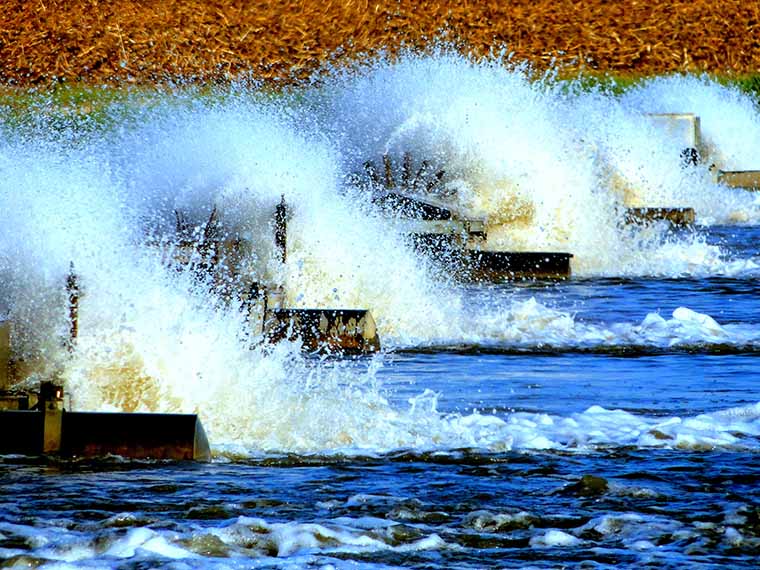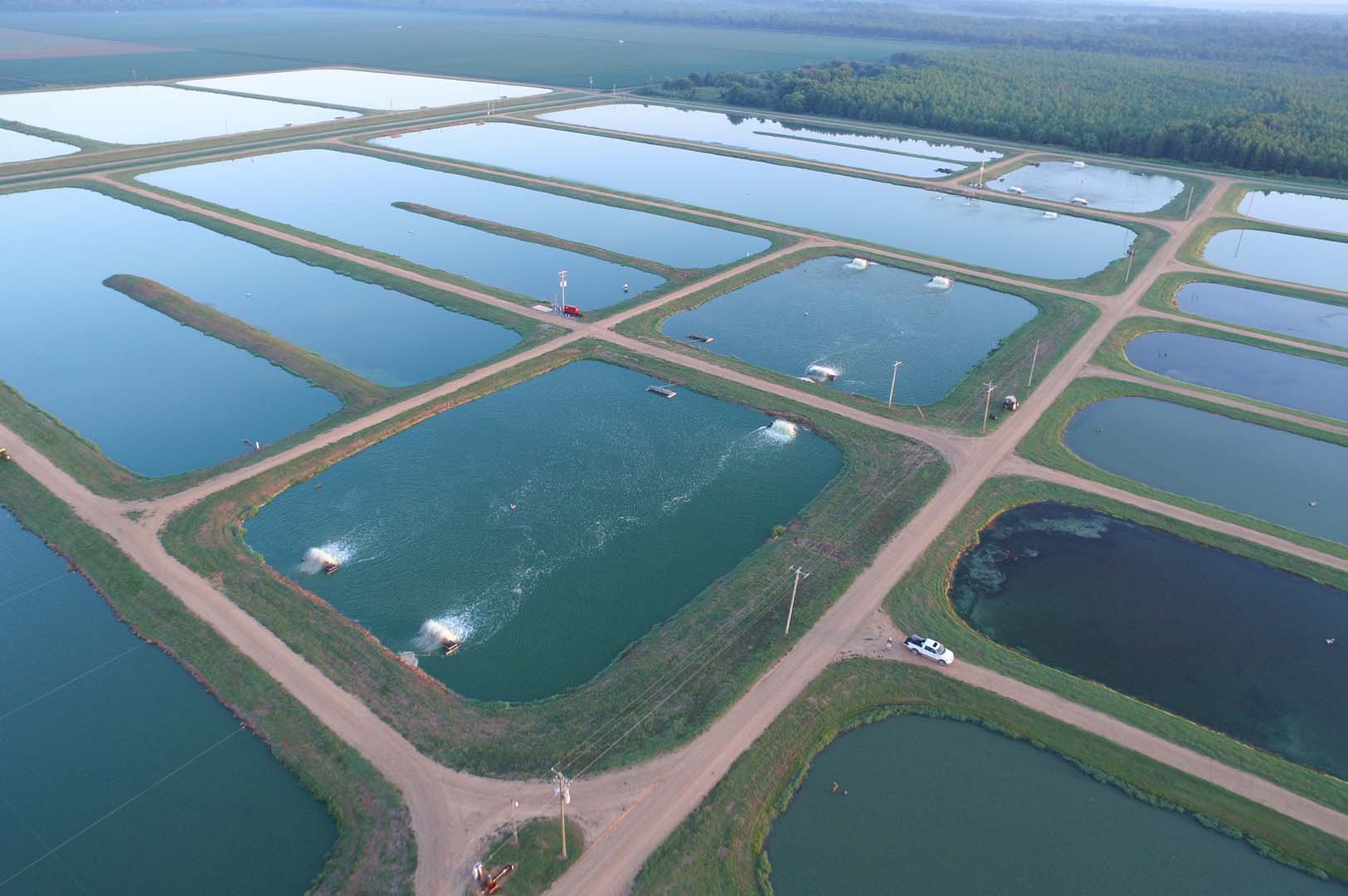The information presented on this page may be dated. It may refer to situations which have changed or people who are no longer affiliated with the university. It is archived as part of Mississippi State University's history.
Recent technological advances in production systems have enabled catfish producers to achieve significantly higher yields. Scientists in the Mississippi Agricultural and Forestry Experiment Station have been at the forefront of these advances, helping producers improve their bottom line.
Gone are the days of 40-acre catfish ponds created during the birth of the commercial catfish industry in the 1960s. "Bigger-the-better" was a common theme back then as a way to reduce pond construction costs. Those bigger ponds were challenging to manage and yields were typically lower than what is found in the industry today.
The advent of nutritionally-balanced diets and paddlewheel aerators allowed producers to better manage ponds. As catfish farmers became more acutely aware of the need to maintain higher dissolved oxygen levels they increased aeration rates to about two horsepower per acre. Progressively, the average pond size shrank to 10-acres as smaller ponds were easier to aerate and manage. However, waste management continued to be a critical gap in these traditional open ponds, limiting fish yields to 4,000-5,000 pounds per acre and preventing producers from taking advantage of economies of scale.
These limitations and the steady rise of feed prices forced many local producers out of business. The remaining farmers had to evolve their production practices to be more efficient. The development of two new technologies-split-pond system and intensively aerated ponds-intensified catfish management.
Scientists in the Thad Cochran National Warmwater Aquaculture Center housed at the Delta Research and Extension Center were at the forefront of the development of these technologies. Dr. Ganesh Kumar, MAFES assistant research professor attributes development of split-pond technology to former MAFES scientist Dr. Craig Tucker.
"Split-pond technology compartmentalized traditional open ponds into a smaller fish-rearing basin occupying about 20 percent of the pond and a larger waste-treatment basin occupying the remaining 80 percent. A high-volume water moving device-a large slow moving paddlewheel or a pump-slowly circulates the water between the two basins," Kumar said.
Though the section of the pond that houses fish is smaller, it can accommodate 150,000 to 200,000 pounds of fish, primarily because of the internalization of nitrogenous wastes within the waste-treatment area of the pond and through better use of paddlewheel aeration within the fish rearing section.
"This technology allows the farmer to have higher yields through greater control over production by concentrating all of their efforts in a substantially smaller portion of the pond, even though the intensity of the fish production is much higher," Kumar said.
Producers also found that smaller ponds were much easier to manage. Also, oxygen supplied through paddlewheels is more evenly distributed in smaller ponds. Fundamental studies conducted by USDA-ARS scientist Dr. Les Torrans, demonstrated the production benefits of maintaining increased oxygen levels in catfish ponds.
"Many farmers began converting their traditional 10-acre ponds into two smaller four- to six-acre ponds. These smaller ponds, referred to as "intensively aerated ponds," are equipped with better aeration rates ranging from five to 10 horsepower per acre. This allows for accommodating more fish resulting in increased yield, ranging from 12,000 to 16,000 pounds per acre," Kumar said. "However, more work must be done on the processing of nitrogenous wastes in these system."
Typically catfish ponds require renovation in eight to 12 years. Renovation costs can range from $2,500 to $3,000 per acre. In such cases, it might be the best for producers to consider splitting the pond and adopting either of these two new technologies.
However, the choice of technology as well as the extent of technology adoption largely depends on availability of upfront capital. Kumar notes that like any business, larger farms typically adopt newer technogies as they have relatively better financial flexibilities and hence could transition greater portions of the farm to these new technologies than could smaller farms.
Perception of risk is another important factor affecting adoption of these technologies. For example, when fish prices are relatively higher, farmers perceive greater benefit from these improved systems. On the other hand, higher feed prices and lower fish prices would shift profit-maximization strategies on farms from split-ponds to intensively aerated systems and traditional single-batch systems. Hence, farmers perceive to have better benefits from adopting these systems when market conditions are more favorable.
Kumar, who has analyzed the costs of the two intensive systems, warns that the upfront investment in the adoption of split-ponds or intensively aerated pond technologies is high.
"Although the yields are higher, modifying catfish production to either of these two intensive systems requires structural modifications and additional equipment," Kumar said. "However, the productivity gains obtained from these systems have led to significant adoption within the industry."
Kumar reiterates the need to consider certain production aspects before adoption of these systems.
"Both of these systems involve high upfront capital as well as increased operating costs. Hybrid catfish fingerlings, which are relatively more expensive than channel catfish, are better suited in these systems as they perform well under higher stocking densities. Additionally, both these technologies are designed to produce more fish out of the unit area, not for over-wintering or holding fish for a longer period of time," Kumar said. "High concentrations of fish in a smaller area also requires a feedman to closely observe the feeding habits of the fish based on the effects of the water currents and how wind affects smaller ponds."
Kumar suggests farms slowly transition into these systems, keeping in mind the production goals of the farm. Producers should consider their marketing ability and business goals before considering these systems as both involve greater financial investments.
Kumar cautions that these systems alone are not the silver bullet for production problems on catfish farms. Adoption of these systems should be based on what one can sell, not produce, the return to investment, financial risk tolerance, and management capabilities of the individual farms, he added.
"Farms that are not vertically integrated should have multiple production strategies on their farms, utilizing hybrid catfish in intensive production systems and channels in traditional multibatch production systems, thus facilitating year-round supply of fish to generate cash flow," Kumar said.
Kumar continued, "The catfish industry is comprised of a resilient group of pioneering farmers. It is incredible to witness the range of management strategies adopted by these farmers to accommodate the dynamic needs of their buyers."
It is also rewarding to be a part of this industry and develop stakeholder-driven research comparing the economic performance of different system designs and optimal densities within these intensive systems, Kumar added.
The marketing study was funded through the Mississippi-Alabama Sea Grant Consortium.


